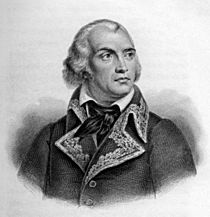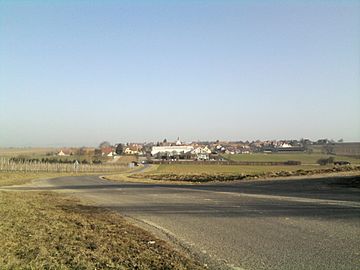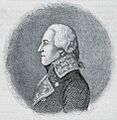Battle of Haguenau (1793) facts for kids
The Battle of Haguenau (November 18 to December 22, 1793) was a long and tough fight during the War of the First Coalition. It happened near Haguenau, a city in France. The French army, led by General Jean-Charles Pichegru, kept attacking the Coalition forces. These forces were a mix of soldiers from Austria, Hesse-Kassel, Bavaria, and French Royalists who were against the new French Republic.
The Coalition army, commanded by General Dagobert Sigmund von Wurmser, had pushed into France earlier. But Pichegru's constant attacks slowly forced Wurmser's army to fall back. After weeks of fighting, especially when the French Army of the Moselle attacked Wurmser's side, the Coalition had to retreat even further. This battle was a big victory for the French Republic.
Quick facts for kids Battle of Haguenau (1793) |
|||||||
|---|---|---|---|---|---|---|---|
| Part of War of the First Coalition | |||||||
|
|||||||
| Belligerents | |||||||
| Commanders and leaders | |||||||
| Units involved | |||||||
| Strength | |||||||
| 57,000 | 41,000 | ||||||
Contents
Why the Battle Happened
The Coalition army had won a battle earlier, the First Battle of Wissembourg, on October 13, 1793. This allowed them to push deep into Alsace, a region in France. The French government was worried and quickly appointed Jean-Charles Pichegru to lead the Army of the Rhine. They told him to attack the Coalition forces.
Two powerful government officials, Louis Antoine de Saint-Just and Philippe-François-Joseph Le Bas, arrived to make sure the army was ready. They were very strict. They made sure officers and soldiers followed rules closely and removed anyone they thought wasn't loyal or performing well. Pichegru took command on October 29, 1793.
The French army had about 57,000 soldiers, with around 42,000 ready for duty. The Coalition army had about 41,000 soldiers.
The Battle Begins
Pichegru started his attacks on the Coalition lines on November 18. General Wurmser, who was from the Alsace region, fought hard to defend his homeland. The French divisions, led by generals like Louis Desaix and Pierre Marie Barthélemy Ferino, pushed forward.
On the French left side, generals Burcy and Ferino pushed back the Coalition forces and threatened the town of Bouxwiller. Wurmser knew that the Prussian army, his ally, was pulling back for winter. So, he ordered his army to retreat closer to the Moder River and Haguenau.
Fighting at Gundershoffen and Berstheim
As the Coalition retreated, the French followed closely. On November 26, General Burcy was ordered to attack a strong Coalition fort near Gundershoffen. He attacked twice and was killed while leading his troops. His replacement, Jacques Maurice Hatry, tried again on December 1 but was also pushed back.
Meanwhile, Ferino's division fought its way to the village of Mommenheim. Here, they faced Austrian soldiers and French Royalists. The Royalists had fortified the village of Berstheim. On December 2, a French officer named Laurent Gouvion Saint-Cyr bravely captured Berstheim with two battalions. However, other French troops advanced too quickly and were caught by surprise by the Royalist cannons and cavalry. The French had to pull back from Berstheim.
On December 8, Saint-Cyr, now leading a reinforced brigade, attacked Berstheim again. This time, the Royalists rushed out to chase the French light troops. But Saint-Cyr's soldiers were ready and fought back hard, causing heavy losses for the Royalists. The next day, Saint-Cyr found that the Royalists had left Berstheim. This was part of Wurmser's plan to move his army back to the Moder River.
Pressure on Wurmser's Flank
Even though Wurmser was able to stop Pichegru's direct attacks on the Moder River, he faced a new problem. Another French army, the Army of the Moselle, led by General Lazare Hoche, started putting pressure on his western side.
Hoche's army began moving eastward, and by December 12, about 22,000 French soldiers were threatening Wurmser's flank. Pichegru and Hoche met on December 14 to plan how their two armies could work together.
A series of battles followed. On December 22, the Army of the Moselle captured the towns of Froeschwiller, Woerth, and Reichshoffen. This was a major blow to Wurmser. With his side now open, he had no choice but to abandon Haguenau and retreat further to the Lauter River. The Army of the Rhine chased him closely.
Outcome of the Battle
The French won the Battle of Haguenau by constantly attacking and wearing down their enemies. Pichegru was very good at using his resources and had smart military advisors like Barthélemy Louis Joseph Schérer and Louis Desaix. He even protected Desaix from being removed from command, showing his good judgment.
This victory was very important. It helped the French lift the Siege of Landau, which had been going on for months. The Coalition forces were defeated, with the Austrians retreating across the Rhine River and the Prussians falling back. The next major battle was the Second Battle of Wissembourg on December 25-26, 1793, where the French continued their success.
Images for kids









